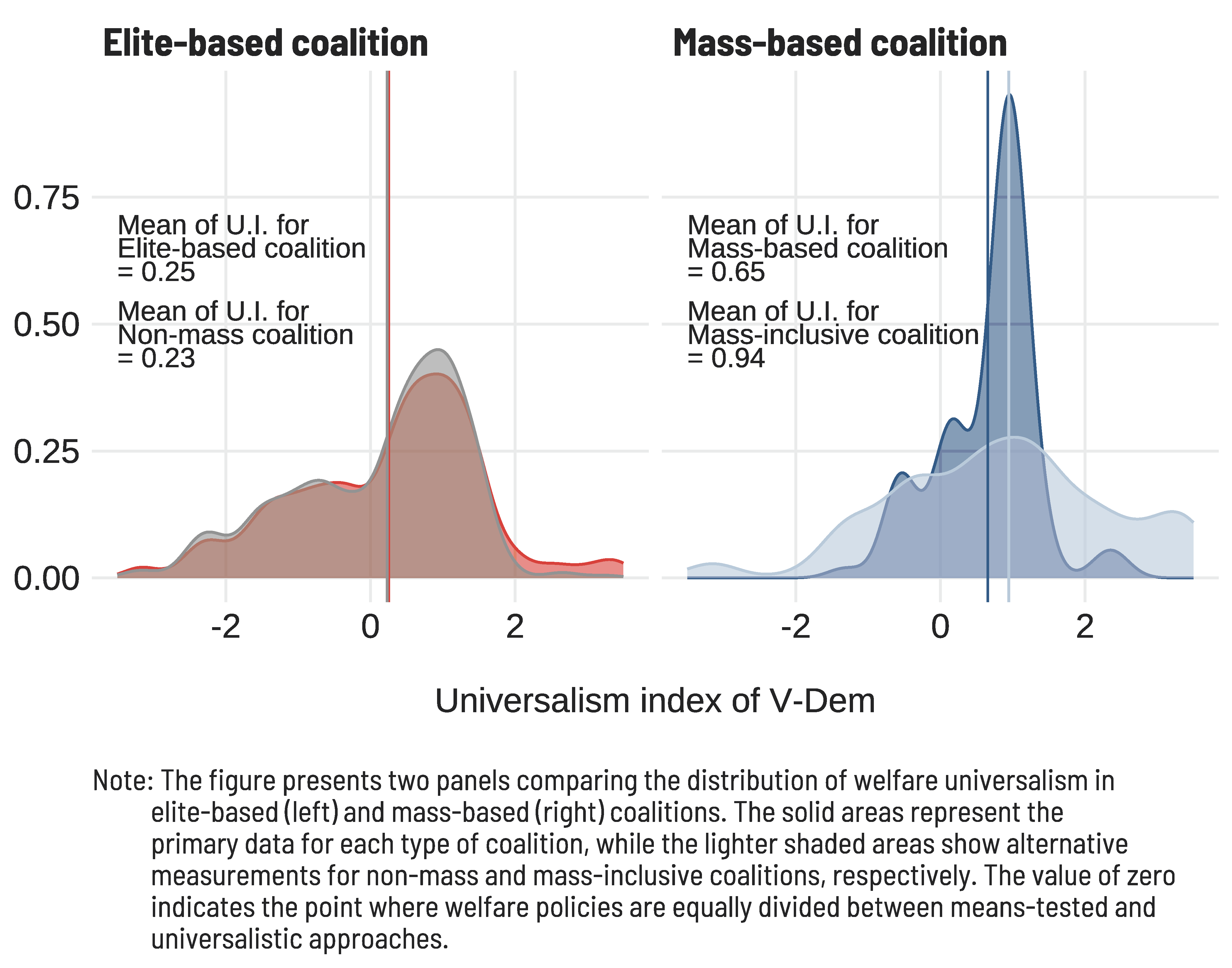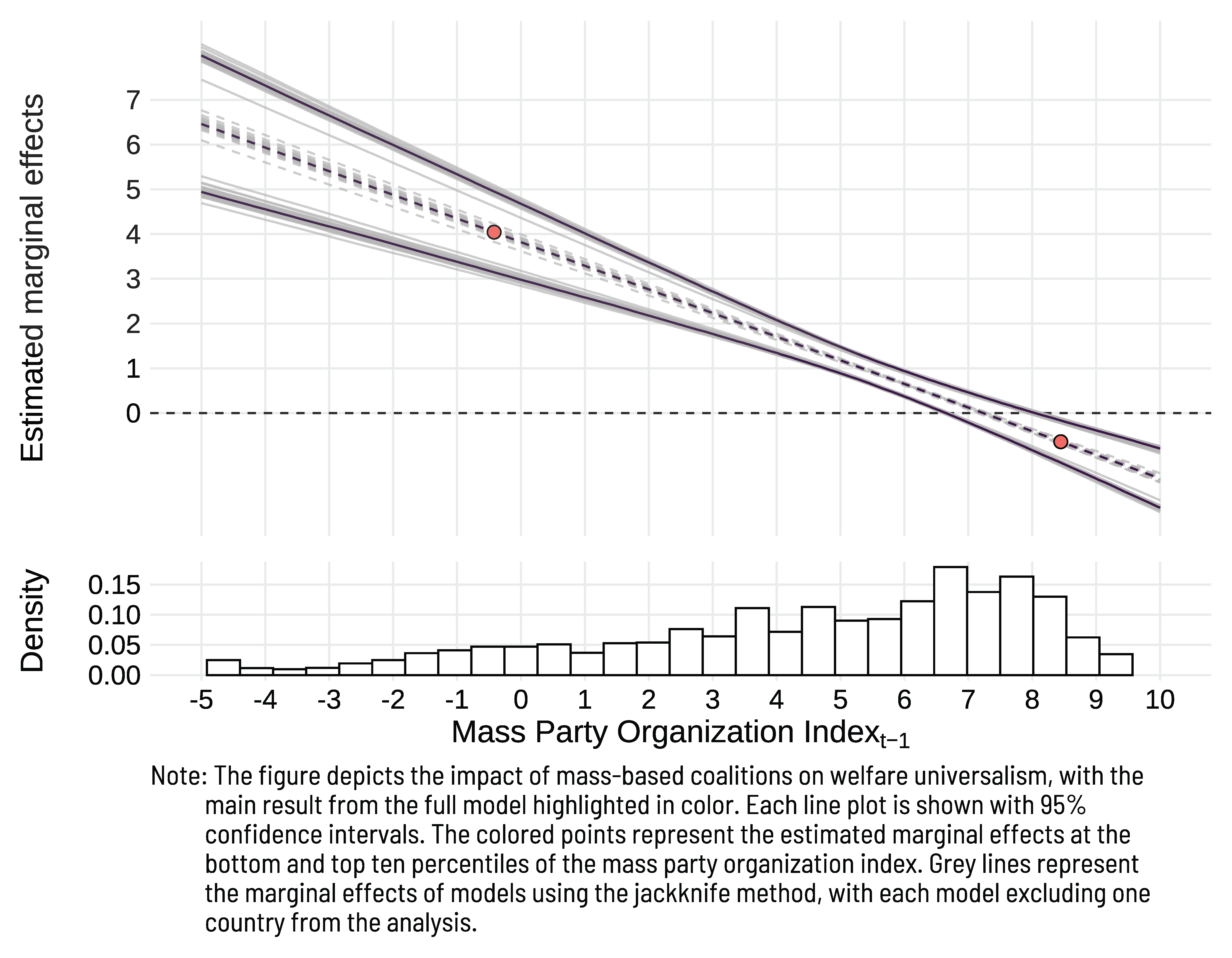Important links
Abstract
Why do authoritarian regimes provide welfare for their citizens? This paper answers this question by examining the information problems faced by autocrats: how well they can identify public preferences and the key groups they must co-opt to stay in power. Despite democracies providing welfare by public demand, authoritarian leaders use welfare provision strategically to maintain their ruling coalitions. I argue that the extent of welfare provision depends on which groups an autocrat relies on for support and their ability to gather information about the population. This is because better information allows them to target benefits more effectively. I examine data on authoritarian regimes and their welfare provisions from 1966-2011. I find that massbased coalitions and strong mass party organizations lead to more universal welfare. Also, the effect of mass-based coalition diminishes when autocrats effectively manage information problems through a well-institutionalized mass party. Strong mass party organizations play an important role in resolving information problems, enabling more efficient targeting, and reducing reliance on universal welfare provisions.
Theory
this paper explores how authoritarian regimes engage in strategic welfare distribution as part of an “authoritarian bargain” to maintain support and manage threats. Welfare provisions are often used as tools for co-optation rather than broad social support, with authoritarian leaders selectively providing benefits to key support groups to secure loyalty. This selective provision is deemed more cost-effective than broad public goods distribution, with welfare strategies deeply influenced by the nature of the leader’s support coalition. The section emphasizes the dynamic formation of these coalitions, which may include elites or masses, each posing different threats and requiring different strategies for co-optation and control.
Three hypotheses are proposed based on the relationship between the type of coalition and welfare provision strategies. Hypothesis 1 suggests that autocrats with mass-based coalitions are more likely to provide universal welfare compared to those supported by elites, as broad welfare initiatives help appease the general public and mitigate threats. Hypothesis 2 argues that stronger mass party organization within a regime enhances the provision of universal welfare, as these parties help gather critical information about public preferences, thus improving the regime’s responsiveness. These organizations not only serve as a means of information gathering but also help in mobilizing support and managing dissent, providing a direct link between the autocrat and the masses.
Hypothesis 1: When an autocrat has a mass-based ruling coalition, the autocrat is more likely to provide universal welfare than when the coalition is based on elites.
Hypothesis 2: When an autocrat has stronger mass party organization, the autocrat is more likely to provide universal welfare.
Finally, Hypothesis 3 posits that the extent of universal welfare provided by autocrats to a mass-based coalition decreases with greater institutionalization of mass party organizations. As these organizations improve information flows and surveillance capabilities, they allow for more targeted and efficient welfare provisions. This suggests a nuanced approach where universal welfare is strategically calibrated to maintain broad support while minimizing excessive reliance on such measures. The theory illustrates a complex interplay between authoritarian control mechanisms, coalition management, and welfare strategies, highlighting the adaptive and strategic nature of authoritarian governance in maintaining power.
Hypothesis 3: The amount of universal welfare an autocrat provides to mass-based coalition diminishes with greater mass party institutionalization.
Data
I use unbalanced time-series cross-sectional (TSCS) data from authoritarian regimes from up to 100 autocracies between 1966 and 2011.
Dependent variable: Welfare universalism
Derived from the V-Dem dataset, this index of welfare universalism is informed by expert coding and reflects the degree to which welfare programs within a given state are means-tested or universally accessible over a specified time period.
Main predictors
Ruling coalition
I identify the different ruling coalitions that affect the levels of the authoritarian welfare state into two: Mass-based ruling coalition and elite-based ruling coalition. When autocrats rely on elite-based coalitions, there exists a communication channel that enables them to resolve information problems, making it more likely for autocrats to provide welfare to their identified supporters.

Mass party organization
Following Reuter (2022), I use a variable of mass party organization, which sums up three measures from the Varieties of Party Identity and Organization (V-Party) dataset: local organizational activity and local branch extensiveness, local organizational extensiveness, and ties to social organizations. I expect that highly institutionalized mass party can solve information problems by allowing autocrats to identify potential dissenters and supporters among masses and absorb the influence of mass-based coalition on welfare provisions, resulting in less universal provisions than without mass-based party organizations.
Results
| Model 1 | Model 2 | Model 3 | Model 4 | |
|---|---|---|---|---|
| Mass-Based Coalition (vs. Elite-Based) | 0.14 (0.09) | 0.81 (0 .14)*** | 3.82 (0 .43)*** | |
| Mass Party Organization Index | 0.05 (0 .01)*** | 0.04 (0 .01)*** | 0.57 (0 .07)*** | |
| Mass-Based Coal ition X Mass Party Organization Index | -0.53 (0 .07)*** | |||
| Ln(GDPpc + 1) | -0.01 (0.05) | 0.05 (0.05) | 0.08 (0.05) | 0.07 (0.05) |
| Annual GDP Growth | 0.67 (0.22)** | 0.09 (0.20) | 0.03 (0.22) | 0.02 (0.22) |
| Resource Dependence (Per GDPpc) | 0.01 (0.01) | 0.01 (0.01) | 0.02 (0.01) | 0.02 (0.01) |
| Civil War Experience | 0.04 (0.03) | 0.02 (0.03) | -0.01 (0.03) | -0.01 (0.03) |
| Repression: Human Rights | 0.07 (0.03)** | 0.11 (0 .03)*** | 0.13 (0 .03)*** | 0.13 (0 .03)*** |
| CSO Consulation | 0.13 (0 .02)*** | -0.01 (0.02) | 0.04 (0.02) | 0.02 (0.02) |
| CSO P articipatory Environment | -0.05 (0.02)** | 0.14 (0 .02)*** | 0.14 (0 .02)*** | 0.13 (0 .02)*** |
| Hereditary Dimension | -0.31 (0.29) | 0.60 (0.34) | 0.45 (0.34) | 0.43 (0.34) |
| Military Dimension | 0.03 (0.06) | 0.16 (0.06)** | 0.17 (0.06)** | 0.12 (0.06) |
| Ruling Party Dimension | 0.37 (0 .09)*** | 0.36 (0 .08)*** | 0.35 (0 .09)*** | 0.30 (0 .09)*** |
| Personalist Dimension | 0.12 (0.05)* | -0.15 (0.05)** | -0.09 (0.05) | -0.10 (0.05) |
| C ountry-fixed | YES | YES | YES | YES |
| Year-fixed | YES | YES | YES | YES |
| Year coverage | 1947-2011 | 1966-2011 | 1966-2011 | 1966-2011 |
| No. of countries | 100 | 100 | 94 | 94 |
| AIC | 3635.64 | 1683.89 | 1480.37 | 1424.05 |
| BIC | 3713.38 | 1757.82 | 1558.29 | 1507.53 |
| R2 | 0.03 | 0.09 | 0.11 | 0.13 |
| Adj. R2 | -0.03 | 0.02 | 0.03 | 0.06 |
| Num. obs. | 2922 | 2180 | 1931 | 1931 |
| ***p < 0.001; **p < 0.01; *p < 0.05 |

Conclusions
The empirical findings show that both mass-based coalitions and well-organized mass parties significantly influence the expansion of universal welfare provision. It suggests that some autocrats, despite the challenges of relying on mass supports, establish institutions that connect them to masses, aiding in threat detection and management. Nonetheless, the establishment of such institutions does not guarantee universal welfare provision. Instead, an improvement in the autocrats’ ability to gather and process information can drive decrease in universal welfare provision.